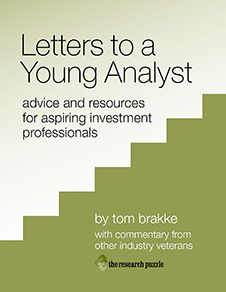
- Tuesday, December 30th, 2014
- conceptual front ends
-
More than thirty years ago, Robert Sinclair wrote “Thinking and Writing: Cognitive Science and Intelligence Analysis.” In 2009, it was republished by the Center for the Study of Intelligence, a unit of the CIA, where Sinclair had worked. The monographCenter for the Study of Intelligence | This is the later version, which includes a new introduction and the original work. is worthwhile reading for anyone involved in investment decision making. (I became aware of it as a result of a posting by Miguel Barbosa on SimoleonSense.SimoleanSense | There are a variety of good readings curated by Barbosa; this is his summary of the Sinclair piece.)
Many of the ideas addressed by Sinclair in the original manuscript have been popularized over the intervening years, but even now, “we have not absorbed the science into the way we think about our analytic jobs.” That characterization fits the investment ecosystem as well. For example, the ideas of behavioral finance have become well known, but it is rare to see them applied in any kind of systematic way to improve the decision process.
There is much to chew on in the monograph. As its title implies, the writing process gets a lot of attention, since written analyses are at the heart of the CIA’s approach. As a writer, I found those sections interesting, but there are broader points about analysis and decision making that extend to organizations with different methodologies.
In the afterward, Sinclair points out “a series of irreconcilable demands” that face “the directorate”; they are quoted in full below (and apply equally well to investment analysis in an organizational setting):
~ Between the individual, private nature of the analytic effort and the social and hierarchical constraints imposed by bureaucratic imperatives.
~ Between the cognitive patterns that are necessary to develop complex ideas (patterns that can only operate through writing) and the patterns our speech- and news-oriented customers are comfortable with.
~ Between the early point at which critical analytic decisions are made and the serial nature of the review process.
~ Between the need to search for new insights — to explore the murkier reaches of a problem space — and the need to avoid mistakes.
To elaborate a bit on some of the points:
The discussions about knowledge versus news (basically, “news” is something that has direct implications for the receiver of the information) and writing versus speaking get at the critical question of how to communicate effectively in an organization.the research puzzle | My formula for any investment role: “analysis plus communication.”
To wit, “writing is capable of breadth and precision; neither complex ideas nor complex organizations would be possible without it.” On the other hand, “speech is a far more general medium of exchange”; it is, in fact, “the medium of decision making.” Bridging the gap between those two modes of communication is incredibly important for all concerned.
And so is thinking about thinking, about the process of analysis. As children, “we all learned to generalize, to impute continuity, to discern relationships, and to determine cause-and-effect.” All of which are helpful much of the time, but not all of the time. There are traps lurking.
Therefore, “analysis is likely to improve when we look beyond what is going on in our own heads — when we use any of several techniques designed to make explicit the underlying structure of our argument and when we encourage others to challenge our analogies and heuristics with their own.” However, “Little about the current process fosters such activities.”
Experience rubs both ways. It helps an analyst to have a database of patterns on which to draw, but “it can also make him or her less open to unusual ideas or information — a phenomenon sometimes termed ‘hardening of the categories.'” And, it’s one thing for a chess grandmaster to be able to draw on fifty thousand stored patterns, but spies and investment analysts are dealing in a changing, “poorly defined problem space.”
Finally, there are the “conceptual front ends” of today’s title.
One involves this kind of high-level thinking about the process — the craft — of analysis. As important as those conceptual issues are, they aren’t addressed at all in most investment organizations. It is worth taking a page from the CIA’s book in that regard. (The author includes worthwhile suggestions about recruitment, training, organizational structure, presentation methods, etc.)
The other kind of “conceptual front end” is that which Sinclair identifies for a specific inquiry. “Being clear what is going on at the beginning takes on overwhelming importance . . . .” It’s not that a mission won’t get modified along the way (it will). But defining the purpose in advance keeps your eyes on the prize; without a clear plan of attack, the analysis is likely to be lackluster.
I read Sinclair’s piece (and am reading other CIA material) as part of my work on due diligence principles and applications.tjb research | Here’s a short summary of the services I provide in that regard. What is the construct within which due diligence is to be performed? What is the problem as defined (and the steps that are anticipated to reveal currently hidden or mis-valued information) for a particular evaluation? A focus on the “how” of those questions is likely to pay dividends for those who take the time.
